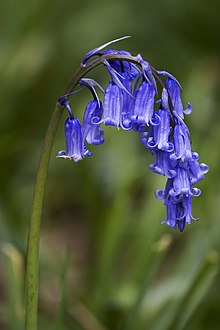Common bluebell
| Hyacinthoides non-scripta | |
|---|---|
 |
|
| Scientific classification | |
| Kingdom: | Plantae |
| Clade: | Angiosperms |
| Clade: | Monocots |
| Order: | Asparagales |
| Family: | Asparagaceae |
| Subfamily: | Scilloideae |
| Genus: | Hyacinthoides |
| Species: | H. non-scripta |
| Binomial name | |
|
Hyacinthoides non-scripta (L.) Chouard ex Rothm. |
|
| Synonyms | |
|
|
Hyacinthoides non-scripta (formerly Endymion non-scriptus or Scilla non-scripta) is a bulbous perennial plant, found in Atlantic areas from north-western Spain to the British Isles, and also frequently used as a garden plant. It is known in English as the common bluebell or simply bluebell, a name which is used in Scotland to refer to the harebell, Campanula rotundifolia. In spring, H. non-scripta produces a nodding, one-sided inflorescence of 5–12 tubular, sweet-scented violet–blue flowers, with strongly recurved tepals, and 3–6 long, linear, basal leaves.
H. non-scripta is particularly associated with ancient woodland where it may dominate the understorey to produce carpets of violet–blue flowers in "bluebell woods", but also occurs in more open habitats in western regions. It is protected under UK law, and in some other parts of its range. A related species, H. hispanica has also been introduced to the British Isles and hybridises with H. non-scripta to produce intermediates known as H. × massartiana.
Hyacinthoides non-scripta was first described by Carl Linnaeus in his seminal 1753 work Species Plantarum, as a species in the genus Hyacinthus. The specific epithet non-scriptus means "unlettered" or "unmarked" and was intended to distinguish this plant from the classical hyacinth of Greek mythology. This mythical flower, which was almost certainly not the modern hyacinth, sprang up from the blood of the dying prince Hyacinthus. His lover, the god Apollo, shed tears that marked the new flower's petals with the letters "AIAI" ("alas") as a sign of his grief.
...
Wikipedia
